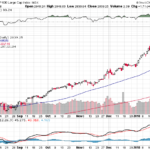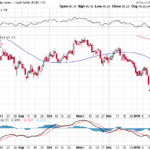I am writing this on Thursday, January 25, 2018. Trading action over the past week has shown how much the stock market has traded off of changes in the value of the dollar. Specifically, earlier this week, Treasury Secretary Mnuchin publicly stated his and the administration’s desire for a weaker dollar. Most administrations have sought a stronger dollar. Not the current administration. The result of Mnuchin’s comments: The Dollar Index dropped almost 1% that day, and the US stock markets soared to new highs. Then, today, while at the annual Davos economic conference, and in an interview on CNBC, President Trump mentioned that he would like to see a strong dollar at some point. The result: A wild ride for the Dollar Index, including a reversal upward of about 1% when Trump made his comments, and a commensurate correction in the stock market.
Tale of Two Charts
Here are charts for the S&P 500 Index and the US Dollar Index for the past several months. Do you see perhaps any correlation between the two?


These charts are since July 2017. If I was able to show you charts since 1/1/17, the negative correlation between the two would be more marked. However, I am not technologically adept enough to figure out how to do that. The takeaway: The stock market has gone up as the Dollar Index has gone down. Dollar Index going down means things like stocks are more expensive in dollar terms.
Inflation
Dollar Index going down also usually means inflation, especially for Americans purchasing imported goods. However, inflation in the US for 2017 was only 2.1%, which is historically low. Of course, that is based on the Fed’s “basket of goods” method, which some consider outdated.
Interest Rates
Dolar Index going down also usually means that interest rates rise in reaction to the currency going down. Yet, US Treasury rates remain in the 2.6% range, at least for the 10 Year Bond. That is also historically low. The Federal Reserve Bank raised rates in December 2017 and indicated there will be more increases in 2018. The Fed affects short-term rates, and long-term rates typically follow, which they have, to some extent. They are still relatively low. There is a lot of debate among large institutional investors regarding rates, as you might expect. My take is that longer-term rates will adjust as the Fed adjusts and that we will not fall into an inverted yield curve situation (where long-term rates are lower than short-term rates) because we are not moving toward an economic recession, which an inverted yield curve portends.
Rest of the World
There is another body of thought that the decline of the Dollar Index is a result of the rest of the world catching up to the US. Europe, in particular, has undergone a great deal of turmoil over the past several years due to issues in Greece, Portugal, Spain, and Italy. If they are not fully corrected, issues in those countries are at least out of the headlines for the time being. There are still negative interest rates in Europe, so there are still major issues there. However, the US Dollar may be just reacting to the rest of the world now being under more stable footing. In addition, as I wrote about in an earlier posting, India is finally getting its economic act together after decades of mismanagement.
IMO
There is a lot of talk about a “perfect storm” of good economic news throughout the world, and that stock markets are going up as a result. I think there are still a lot of geopolitical risks out there and that the US Dollar has traditionally been a safe haven in times of turmoil. That said, I do believe you should hold on to any assets you currently own – stocks, real estate, or other valuable assets. If you don’t already own, it’s not too late. Trends in the values of currencies tend to take a long time – months and years – to play out. The new Fed Chairman (Powell) does not seem like the type to upset the apple cart, meaning he will likely not raise interest rates any more than has been projected. This is more good news for stocks.
